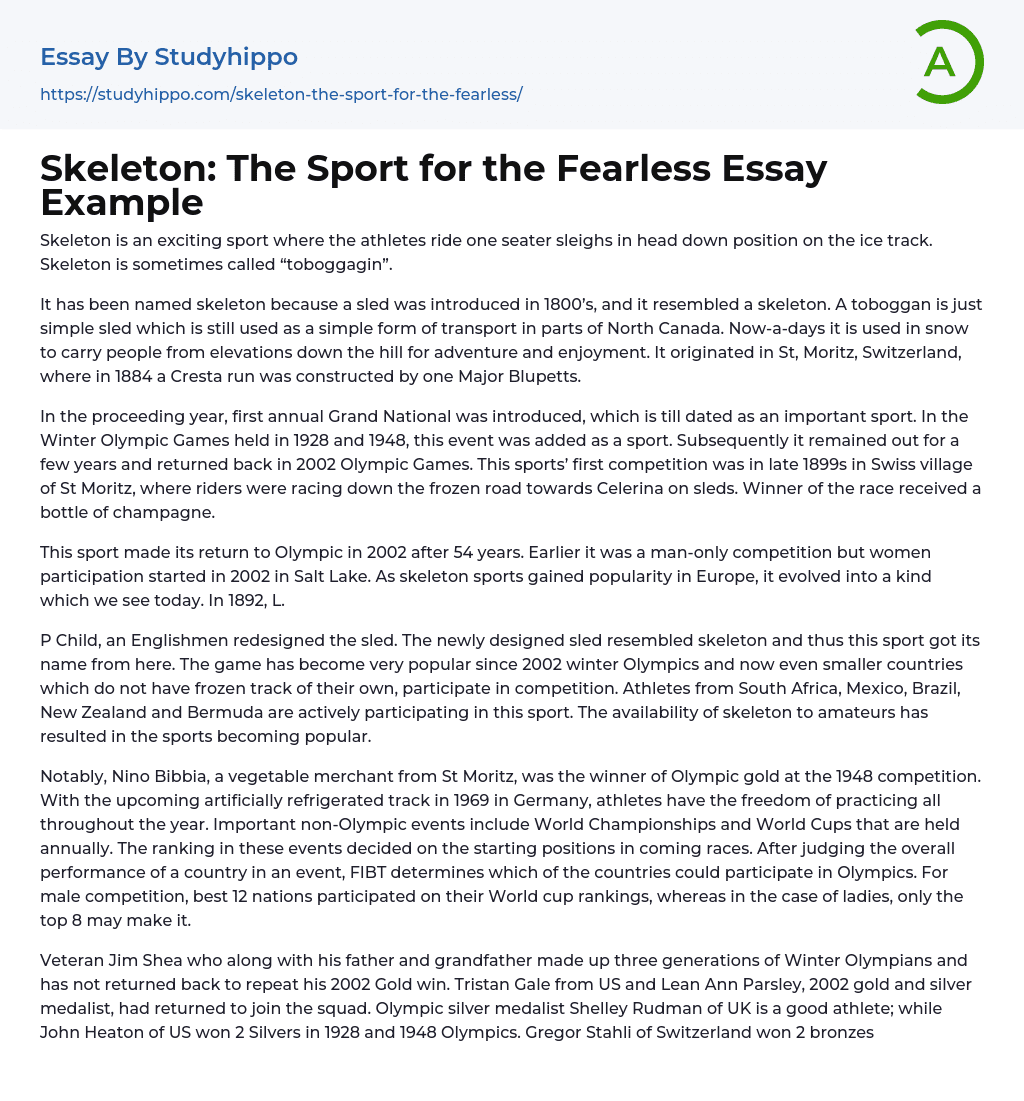Skeleton is an exciting sport where the athletes ride one seater sleighs in head down position on the ice track. Skeleton is sometimes called “toboggagin”.
It has been named skeleton because a sled was introduced in 1800’s, and it resembled a skeleton. A toboggan is just simple sled which is still used as a simple form of transport in parts of North Canada. Now-a-days it is used in snow to carry people from elevations down the hill for adventure and enjoyment. It originated in St, Moritz, Switzerland, where in 1884 a Cresta run was constructed by one Major Blupetts.
In the proceeding year, first annual Grand National was introduced, which is till dated as an important sport. In the Winter Olympic Games held in 1928 and 1948, this event was added as a sport. Subsequently it re
...mained out for a few years and returned back in 2002 Olympic Games. This sports’ first competition was in late 1899s in Swiss village of St Moritz, where riders were racing down the frozen road towards Celerina on sleds. Winner of the race received a bottle of champagne.
This sport made its return to Olympic in 2002 after 54 years. Earlier it was a man-only competition but women participation started in 2002 in Salt Lake. As skeleton sports gained popularity in Europe, it evolved into a kind which we see today. In 1892, L.
P Child, an Englishmen redesigned the sled. The newly designed sled resembled skeleton and thus this sport got its name from here. The game has become very popular since 2002 winter Olympics and now even smaller countries which do not have frozen track of their own
participate in competition. Athletes from South Africa, Mexico, Brazil, New Zealand and Bermuda are actively participating in this sport. The availability of skeleton to amateurs has resulted in the sports becoming popular.
Notably, Nino Bibbia, a vegetable merchant from St Moritz, was the winner of Olympic gold at the 1948 competition. With the upcoming artificially refrigerated track in 1969 in Germany, athletes have the freedom of practicing all throughout the year. Important non-Olympic events include World Championships and World Cups that are held annually. The ranking in these events decided on the starting positions in coming races. After judging the overall performance of a country in an event, FIBT determines which of the countries could participate in Olympics. For male competition, best 12 nations participated on their World cup rankings, whereas in the case of ladies, only the top 8 may make it.
Veteran Jim Shea who along with his father and grandfather made up three generations of Winter Olympians and has not returned back to repeat his 2002 Gold win. Tristan Gale from US and Lean Ann Parsley, 2002 gold and silver medalist, had returned to join the squad. Olympic silver medalist Shelley Rudman of UK is a good athlete; while John Heaton of US won 2 Silvers in 1928 and 1948 Olympics. Gregor Stahli of Switzerland won 2 bronzes in 2002 and 2006 Olympics. Jon Montgomery from Canada and Amy Williams from Britain won the 2010 skeleton at Vancouver Winter Olympics, Canada. Jon Montgomery succeeded with 0.07 seconds; while she managed to win with 3 mins, 35.64 seconds.
- American Football essays
- Athletes essays
- Athletic Shoe essays
- badminton essays
- Baseball essays
- Basketball essays
- Benefits of Exercise essays
- Bodybuilding essays
- Boxing essays
- cricket essays
- Fight club essays
- Football essays
- go kart essays
- Golf essays
- Gym essays
- hockey essays
- Martial Arts essays
- Motorcycle essays
- Olympic Games essays
- Running essays
- scuba diving essays
- Ski essays
- snowboarding essays
- Soccer essays
- Sportsmanship essays
- Super Bowl essays
- Surfing essays
- Swimming essays
- Table tennis essays
- Taekwondo essays
- Tennis essays
- Training essays
- Volleyball essays
- wrestling essays
- Yoga essays
- Beach essays
- Birthday essays
- Christmas essays
- Halloween essays
- Journey essays
- New Year essays
- Recreation essays
- Thanksgiving essays
- Spring essays
- Winter essays




